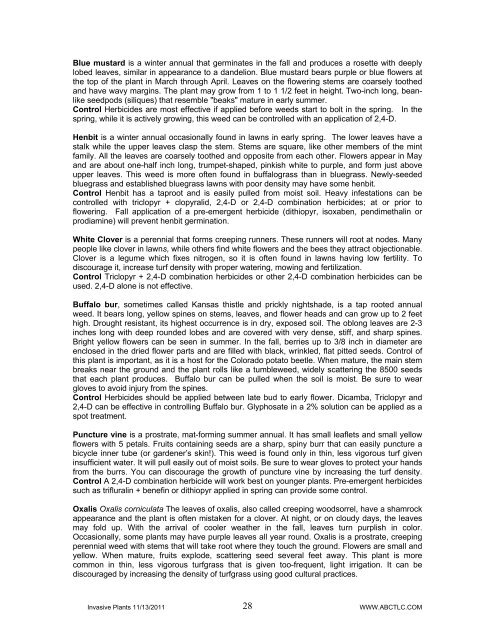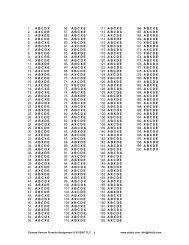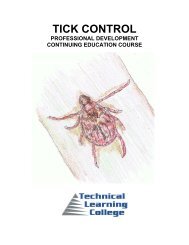INVASIVE PLANTS - Technical Learning College
INVASIVE PLANTS - Technical Learning College
INVASIVE PLANTS - Technical Learning College
Create successful ePaper yourself
Turn your PDF publications into a flip-book with our unique Google optimized e-Paper software.
Blue mustard is a winter annual that germinates in the fall and produces a rosette with deeply<br />
lobed leaves, similar in appearance to a dandelion. Blue mustard bears purple or blue flowers at<br />
the top of the plant in March through April. Leaves on the flowering stems are coarsely toothed<br />
and have wavy margins. The plant may grow from 1 to 1 1/2 feet in height. Two-inch long, beanlike<br />
seedpods (siliques) that resemble "beaks" mature in early summer.<br />
Control Herbicides are most effective if applied before weeds start to bolt in the spring. In the<br />
spring, while it is actively growing, this weed can be controlled with an application of 2,4-D.<br />
Henbit is a winter annual occasionally found in lawns in early spring. The lower leaves have a<br />
stalk while the upper leaves clasp the stem. Stems are square, like other members of the mint<br />
family. All the leaves are coarsely toothed and opposite from each other. Flowers appear in May<br />
and are about one-half inch long, trumpet-shaped, pinkish white to purple, and form just above<br />
upper leaves. This weed is more often found in buffalograss than in bluegrass. Newly-seeded<br />
bluegrass and established bluegrass lawns with poor density may have some henbit.<br />
Control Henbit has a taproot and is easily pulled from moist soil. Heavy infestations can be<br />
controlled with triclopyr + clopyralid, 2,4-D or 2,4-D combination herbicides; at or prior to<br />
flowering. Fall application of a pre-emergent herbicide (dithiopyr, isoxaben, pendimethalin or<br />
prodiamine) will prevent henbit germination.<br />
White Clover is a perennial that forms creeping runners. These runners will root at nodes. Many<br />
people like clover in lawns, while others find white flowers and the bees they attract objectionable.<br />
Clover is a legume which fixes nitrogen, so it is often found in lawns having low fertility. To<br />
discourage it, increase turf density with proper watering, mowing and fertilization.<br />
Control Triclopyr + 2,4-D combination herbicides or other 2,4-D combination herbicides can be<br />
used. 2,4-D alone is not effective.<br />
Buffalo bur, sometimes called Kansas thistle and prickly nightshade, is a tap rooted annual<br />
weed. It bears long, yellow spines on stems, leaves, and flower heads and can grow up to 2 feet<br />
high. Drought resistant, its highest occurrence is in dry, exposed soil. The oblong leaves are 2-3<br />
inches long with deep rounded lobes and are covered with very dense, stiff, and sharp spines.<br />
Bright yellow flowers can be seen in summer. In the fall, berries up to 3/8 inch in diameter are<br />
enclosed in the dried flower parts and are filled with black, wrinkled, flat pitted seeds. Control of<br />
this plant is important, as it is a host for the Colorado potato beetle. When mature, the main stem<br />
breaks near the ground and the plant rolls like a tumbleweed, widely scattering the 8500 seeds<br />
that each plant produces. Buffalo bur can be pulled when the soil is moist. Be sure to wear<br />
gloves to avoid injury from the spines.<br />
Control Herbicides should be applied between late bud to early flower. Dicamba, Triclopyr and<br />
2,4-D can be effective in controlling Buffalo bur. Glyphosate in a 2% solution can be applied as a<br />
spot treatment.<br />
Puncture vine is a prostrate, mat-forming summer annual. It has small leaflets and small yellow<br />
flowers with 5 petals. Fruits containing seeds are a sharp, spiny burr that can easily puncture a<br />
bicycle inner tube (or gardener’s skin!). This weed is found only in thin, less vigorous turf given<br />
insufficient water. It will pull easily out of moist soils. Be sure to wear gloves to protect your hands<br />
from the burrs. You can discourage the growth of puncture vine by increasing the turf density.<br />
Control A 2,4-D combination herbicide will work best on younger plants. Pre-emergent herbicides<br />
such as trifluralin + benefin or dithiopyr applied in spring can provide some control.<br />
Oxalis Oxalis corniculata The leaves of oxalis, also called creeping woodsorrel, have a shamrock<br />
appearance and the plant is often mistaken for a clover. At night, or on cloudy days, the leaves<br />
may fold up. With the arrival of cooler weather in the fall, leaves turn purplish in color.<br />
Occasionally, some plants may have purple leaves all year round. Oxalis is a prostrate, creeping<br />
perennial weed with stems that will take root where they touch the ground. Flowers are small and<br />
yellow. When mature, fruits explode, scattering seed several feet away. This plant is more<br />
common in thin, less vigorous turfgrass that is given too-frequent, light irrigation. It can be<br />
discouraged by increasing the density of turfgrass using good cultural practices.<br />
Invasive Plants 11/13/2011 28<br />
WWW.ABCTLC.COM

















